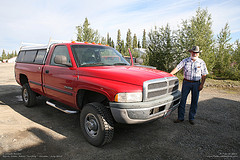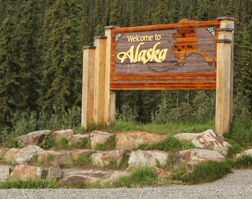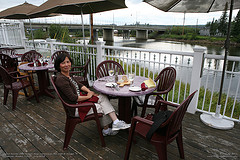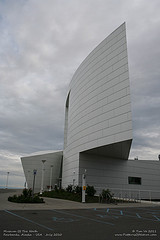We woke up early and left the Lake Creek campground without making breakfast, opting to find something to eat at Beaver Creek instead. The morning air was quite crisp at just 41° F, unlike the warm 70's when we went to sleep. The road from this point on was horrible at places, with both wavy patterns and gigantic pot holes likely due to permafrost. We finally appreciated the warning given to us at the Whitehorse Visitor Center. At times, we had to drive on the side of the road, and at other times we had to drive on the opposing traffic lane to avoid these obstacles. We joked that the Canadians knew where to put their priority for road repair - there was practically no more town to the Alaska border.
 Despite the early hours, we found a cozy restaurant serving breakfast in Beaver Creek. That was our first nice breakfast with hot food, hot coffee and warm room in several days, making us appreciate the simple pleasures so much more. We shared a table with a retired teacher from Alaska. We had a fascinating conversation about his teaching life - he taught at some remote Eskimo town, where he had a place at the school to stay, and the only way to get in and out was by hydroplane. Now that he had retired, he still made a yearly trip to Fairbanks where he owned a small cabin. It turned out that he also lived in California within a hundred miles or so from where we live. What a small world! Beaver Creek itself was a typical small western Canadian service town along the Alaska Highway with the distinction of being the most westerly settlement in Canada.
Despite the early hours, we found a cozy restaurant serving breakfast in Beaver Creek. That was our first nice breakfast with hot food, hot coffee and warm room in several days, making us appreciate the simple pleasures so much more. We shared a table with a retired teacher from Alaska. We had a fascinating conversation about his teaching life - he taught at some remote Eskimo town, where he had a place at the school to stay, and the only way to get in and out was by hydroplane. Now that he had retired, he still made a yearly trip to Fairbanks where he owned a small cabin. It turned out that he also lived in California within a hundred miles or so from where we live. What a small world! Beaver Creek itself was a typical small western Canadian service town along the Alaska Highway with the distinction of being the most westerly settlement in Canada.
Our crossing the border to Alaska was fun unlike my many re-entries to the US at airports where things are always businesslike. Here, after asking us the typical questions, the friendly border officer offered to stamp our passport to prove that we entered Canada by land. Now that I think about it, that was a badge of honor since most people probably visit Alaska by sea or by air. Unfortunately, things went downhill from that point on, with countless road repairs that really slowed us down. Our conjecture that road repair crews would take Sundya off turned out to be wishful thinking - they were working probably even harder on weekends. While it was inconvenient for our travel, we were definitely grateful for the hard work. We'd rather bake this inconvenience and delays into travel plans than putting up with the road condition we had encountered earlier in the day.
 Having entered Alaska, we felt safe and let our guard down - a big mistake. As we drove into Tok, we were busy observing the town and not paying attention to the gas needle. As we drove past the outskirt of town, we finally notice the low gas, but rationalized that since we were on a main thoroughfare to Delta Junction, we could fill up easy enough at one of the gas station along the way. So rather than driving a few miles back to Tok to fill up, we drove on. And there was indeed a town called Dot Lake on the map half-way to Delta Junction. After some 40 miles, we saw the sign for the town of Dot Lake. After we drove past the post office (good sign - the town was large enough to have a post office), we drove past another house then entered a stretch of forest section. Assuming we just got past the boundary of the town (many towns in Canada was like that - you'd see the sign of a town, then would have to drive a couple of miles before you get to downtown area), we kept driving expecting to find a busy downtown momentarily. After 3 miles without any sign of civilization, we got concerned and decided to return to the houses we passed to ask for information. The first house was not occupied, which dashed our hope as we did not have any expectation to find an open post office on a Sunday. After considering our options, we opted to drive back to Tok as we would be able to reach it, rather than risking running out of gas before Delta Junction. So grudgingly we started our way back to Tok. But I decided to check out the post office just in case. We saw a nice lady probably in her 70's watering the garden. So we asked her whether we could find gas anywhere. She said she did not think so, but asked her son to come talk with us. Her son turned out to be the postmaster who lived on premise. He offered us a few gallons of gas, and mentioned there had been more than a few people getting into the same situation we did. We were more than happy to get the gas and paid him the reasonable price he asked for. At the end, we only lost around 20 minutes and a lot of sweats. I was thinking back to the previous day when we helped another traveler out and wondered whether that helped us get the help we did the following day. In any event, we were quite thankful! From that moment on, we always paid attention to our gas needle and fill up at no less than quarter-tank full. Our assumptions about Alaska being similar to the lower 48 states could not be more wrong. We forgot that for the huge size of the state at one-fifth of all 48 states and over a third of its population of 700 thousands congregating in Anchorage, there would not be a lot of people left to spread around. In Alaska, there are many 'towns' on the map with no service what so ever. When researching for this post, I was surprised to find a page dedicated to Dot Lake, and not surprisingly with a population of 38.
Having entered Alaska, we felt safe and let our guard down - a big mistake. As we drove into Tok, we were busy observing the town and not paying attention to the gas needle. As we drove past the outskirt of town, we finally notice the low gas, but rationalized that since we were on a main thoroughfare to Delta Junction, we could fill up easy enough at one of the gas station along the way. So rather than driving a few miles back to Tok to fill up, we drove on. And there was indeed a town called Dot Lake on the map half-way to Delta Junction. After some 40 miles, we saw the sign for the town of Dot Lake. After we drove past the post office (good sign - the town was large enough to have a post office), we drove past another house then entered a stretch of forest section. Assuming we just got past the boundary of the town (many towns in Canada was like that - you'd see the sign of a town, then would have to drive a couple of miles before you get to downtown area), we kept driving expecting to find a busy downtown momentarily. After 3 miles without any sign of civilization, we got concerned and decided to return to the houses we passed to ask for information. The first house was not occupied, which dashed our hope as we did not have any expectation to find an open post office on a Sunday. After considering our options, we opted to drive back to Tok as we would be able to reach it, rather than risking running out of gas before Delta Junction. So grudgingly we started our way back to Tok. But I decided to check out the post office just in case. We saw a nice lady probably in her 70's watering the garden. So we asked her whether we could find gas anywhere. She said she did not think so, but asked her son to come talk with us. Her son turned out to be the postmaster who lived on premise. He offered us a few gallons of gas, and mentioned there had been more than a few people getting into the same situation we did. We were more than happy to get the gas and paid him the reasonable price he asked for. At the end, we only lost around 20 minutes and a lot of sweats. I was thinking back to the previous day when we helped another traveler out and wondered whether that helped us get the help we did the following day. In any event, we were quite thankful! From that moment on, we always paid attention to our gas needle and fill up at no less than quarter-tank full. Our assumptions about Alaska being similar to the lower 48 states could not be more wrong. We forgot that for the huge size of the state at one-fifth of all 48 states and over a third of its population of 700 thousands congregating in Anchorage, there would not be a lot of people left to spread around. In Alaska, there are many 'towns' on the map with no service what so ever. When researching for this post, I was surprised to find a page dedicated to Dot Lake, and not surprisingly with a population of 38.
With enough gas to reach Delta Junction, we left Dot Lake very thankful for the kindness we received. The road was fairly level, with occasional bridges crossing rivers that are typically muddy and wide, most often time filled with dead trees. We later found out that this was the doing of glaciers moving down the mountains, carrying with them rock boulders, dirt and trees. These debris would over time block river passages, forcing it to make new channels. Delta Junction, despite its fame as the end of the Alaska Highway, was a rather small town with a population at less than a thousand. Delta Junction did not seem to care too much about the Alaska Highway or at least we found nothing resembling what we saw in Dawson Creek. There was at least a supermarket and a couple of gas stations. Having learned our lesson, we filled up at the first gas station we found.

 After a short rest at Delta Junction, we eagerly headed toward Fairbanks, our first real stop in Alaska. The road from Delta Junction to Fairbanks was rather plain compared to the sceneries we found in Canada. There were hills, rivers and lakes along the freeway, but mostly what we'd find along most countryside. The few things that we found interesting were the sight of the Alaska oil pipeline, and a stop to learn about the Gold Rush history in Alaska. By mid afternoon, we arrived at Fairbanks. Again, the city was smaller than what we imagined, given all the tourist information we received about it being a major destination. At over 35 thousands people, it is the second largest city in Alaska, and the largest in the interior region. There are plenty of services in Fairbanks. Without GPS service in Alaska, we relied on the old fashion maps to find our ways. After taking a few detours, we found our hotel, and checked in. What a luxury to have nice beds, hot shower, and air conditioning! We found a nice restaurant on the bank of Chena River. Just barely sitting down at our riverside patio dining table, a big shower dumped rain on us, forcing us to retreat back inside. The dinner was great, and so was the desert.
After a short rest at Delta Junction, we eagerly headed toward Fairbanks, our first real stop in Alaska. The road from Delta Junction to Fairbanks was rather plain compared to the sceneries we found in Canada. There were hills, rivers and lakes along the freeway, but mostly what we'd find along most countryside. The few things that we found interesting were the sight of the Alaska oil pipeline, and a stop to learn about the Gold Rush history in Alaska. By mid afternoon, we arrived at Fairbanks. Again, the city was smaller than what we imagined, given all the tourist information we received about it being a major destination. At over 35 thousands people, it is the second largest city in Alaska, and the largest in the interior region. There are plenty of services in Fairbanks. Without GPS service in Alaska, we relied on the old fashion maps to find our ways. After taking a few detours, we found our hotel, and checked in. What a luxury to have nice beds, hot shower, and air conditioning! We found a nice restaurant on the bank of Chena River. Just barely sitting down at our riverside patio dining table, a big shower dumped rain on us, forcing us to retreat back inside. The dinner was great, and so was the desert.
Finishing dinner around 9 PM, with the sun still high in the sky and nothing else to do, we drove around town, then drove to the Museum of the North as recommended by our new friend the retired teacher.This late and short visit turned out to be the highlight of the day. The building itself was a work of art, which served as prelude to the displays inside. There was an impressive collection of the natural world and human histories through the centuries. There were also art displays by both indeginous and contemporary artists. We had to do the tour of the museum in two days since we got there so late, and there was a lot to see and learn.
We left the museum around 10 PM and it was still not dark. So we drove around a bit more, then went back to the hotel, closed all curtain and had a great night of rest.
As this was primarily a travel day, we did not take too many photos, but a few on the road, Fairbanks and the Museum of the North can be found here.
Roads and Weather
We finally understood what folks at the visitor centers warned us about poor road condition. The road section from Beaver Creek to the Alaska border lived up to its notoriety - full of pot holes, uneven surfaces from permafrost damages, evidenced by guardrails forming shapes of hills after being damaged by permafrost. There were many times when we wound up driving on the other side of the road to avoid bad road sections. We could now appreciate the difficulties RVs and those with big trailers had driving in this area. This video provides an example of a bad road section. I could only imagine that since this section of road serves no useful purposes to Canada, it was left to such poor maintenance condition.
The weather was nice and sunny through most of the day, with the exception of an evening shower that drove us from a riverside dining table to inside. The temperature range was nice and comfortable.
Useful links
Beaver Creek article by wikipedia
Dot Lake
Delta Junction
Fairbanks - wikipedia page, tourist information, Museum of the North, Explore Fairbanks, River Boat Discovery